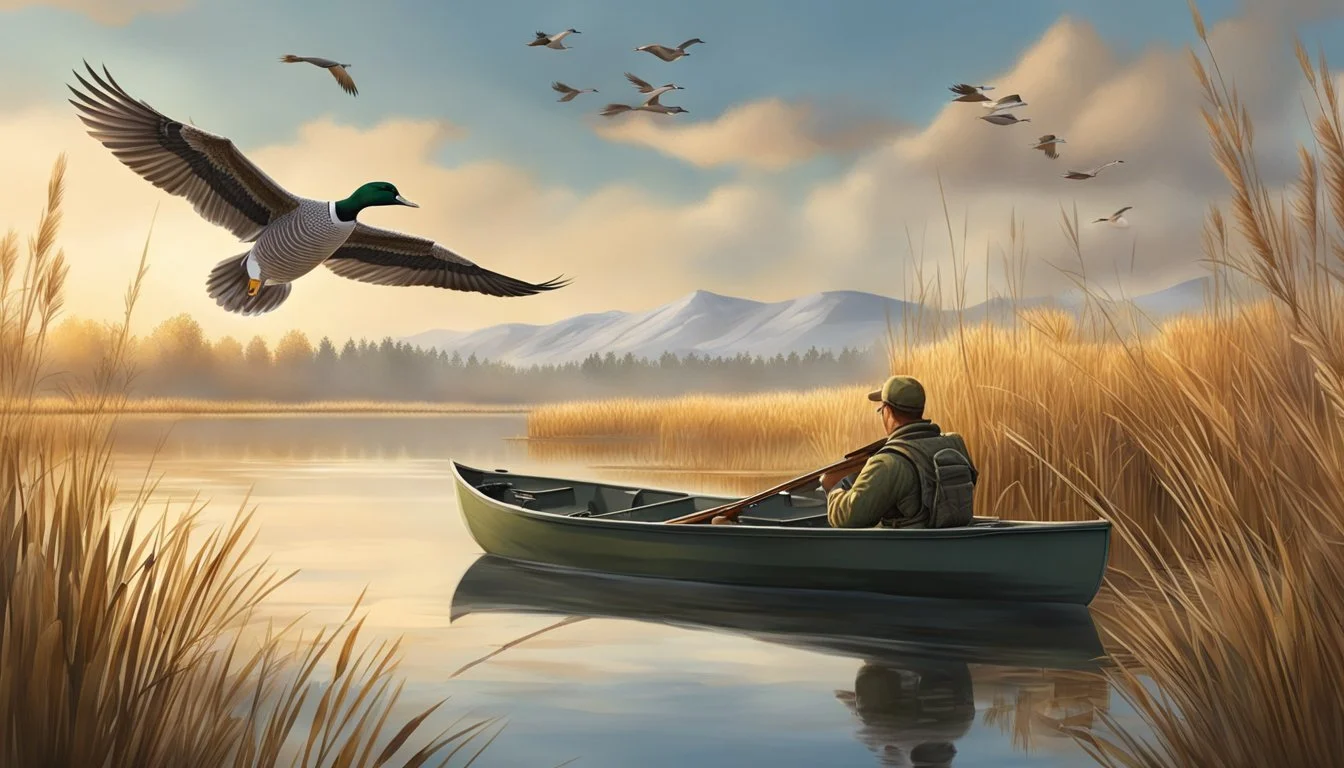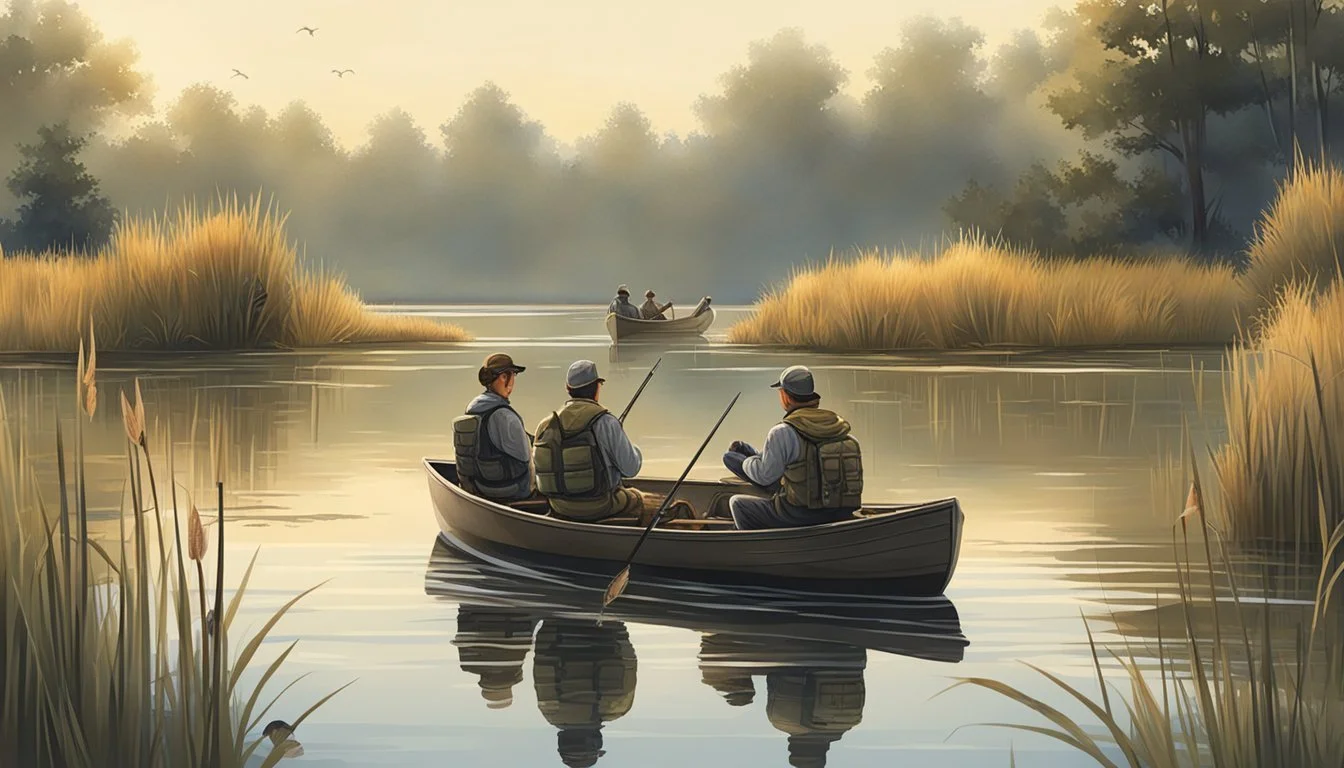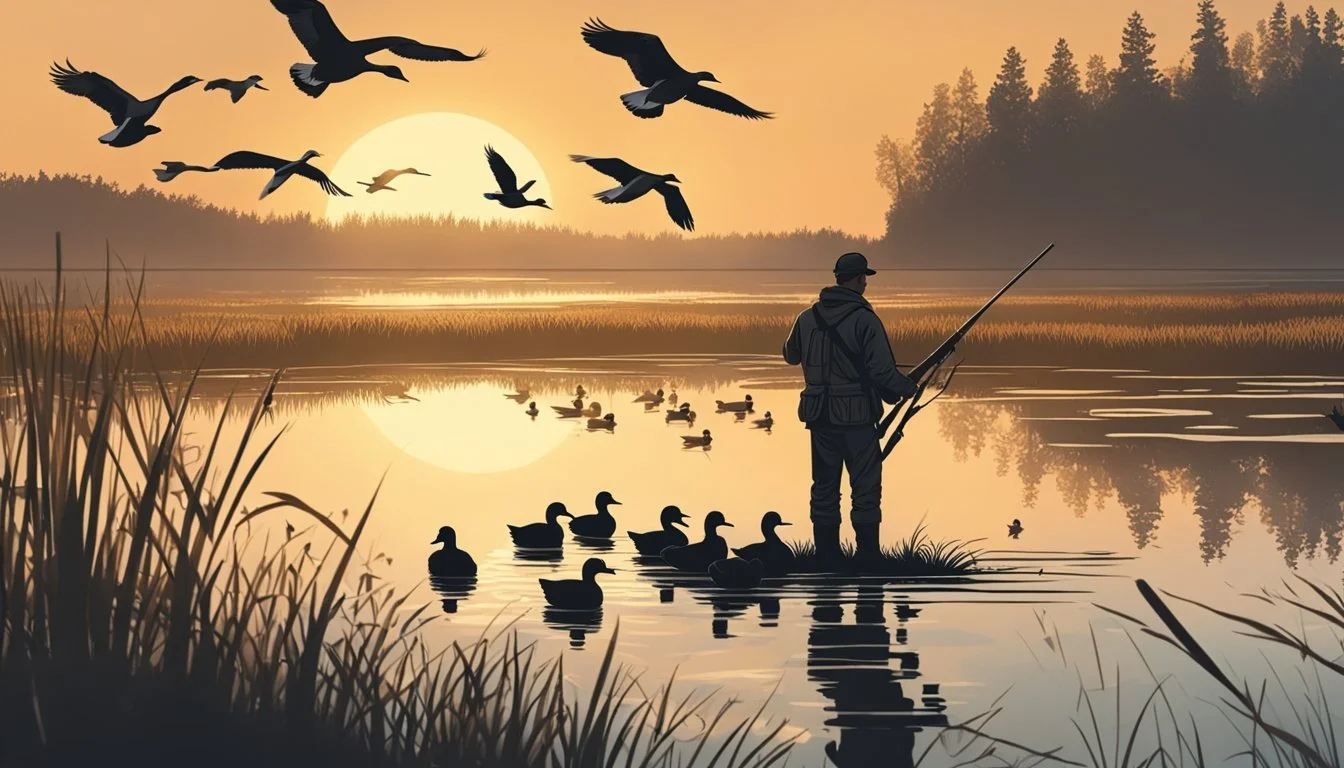Waterfowl Hunting for Beginners
Essential Tips for Getting Started
Waterfowl hunting presents a dynamic outdoor activity that combines skill, patience, and appreciation for nature. At its core, it involves the pursuit of game such as ducks (What wine goes well with duck?) and geese, which requires a thorough understanding of waterfowl behavior, habitats, and conservation practices. As beginners approach this sport, they find that successful waterfowl hunting is as much about preparation and strategy as it is about marksmanship. Essential gear such as appropriate firearms, ammunition, waders, and camouflage clothing are foundational elements to get started.
In waterfowl hunting, scouting is just as crucial as the hunt itself. Beginners must learn to identify potential hotspots where waterfowl are likely to feed and roost. Understanding migratory patterns and weather impacts can also enhance opportunities for a successful hunt. Basic calls and decoys become invaluable tools in a hunter's arsenal, helping to attract ducks and geese within range. As novices gain experience, they generally discover that refinement of their techniques can lead to more rewarding waterfowl hunting outings.
Importantly, ethical waterfowl hunting practices and adherence to wildlife conservation laws ensure the sustainability of waterfowl populations for future generations. Hunters are encouraged to educate themselves on local regulations and required licenses before setting out. This not only protects the hunter and the sport but also reflects a commitment to preserving the waterfowl hunting tradition responsibly. The U.S. Fish and Wildlife Service is ultimately responsible for regulating migratory bird hunting in the United States. For almost 90 years the Federal Duck Stamp program, run by the Fish and Wildlife Service, has supported the conservation of more than 6 million acres of wetland habitat.
Understanding Waterfowl Hunting
Waterfowl hunting is a complex activity that demands knowledge of species, behavior, and habitat, as well as a solid understanding of legal and ethical considerations. It also involves an awareness of safety, hunting etiquette, and conservation efforts that are crucial for sustainable hunting practices.
Waterfowl Species Identification
Successful waterfowl hunters must be proficient in identifying various species of ducks and geese. Ducks can range from mallards with their distinctive green heads to the speckled plumage of teal. Geese include larger birds like the Canada goose, known for its black head and neck with a white “chinstrap." Recognition is crucial not only for the hunt but also for adhering to bag limits that are often species-specific. Other types of common waterfowl species include Canada geese, snow geese, wood ducks, Ross's geese, northern pintail, and sea ducks.
Waterfowl Behavior and Habitat
Understanding the feeding patterns and preferred habitats of waterfowl leads to successful waterfowl hunting. Ducks are often found in ponds and lakes where they can feed on aquatic vegetation and small invertebrates. Geese might be spotted in larger water bodies and adjacent grassy areas for grazing. Recognizing natural surroundings that serve as feeding grounds is essential for finding birds in waterfowl hunting.
Regulations and Ethics
Each region has specific regulations to hunt waterfowl, including bag limits, permits, and seasons, which all hunters must follow. It is the hunter's responsibility to obtain the necessary permission to hunt from landowners and to possess the correct permits. Adhering to ethical hunting practices involves respecting these regulations and the principles of fair chase. Contact the Fish and Wildlife Service for regulation details.
Hunting Safety and Etiquette
Safety is paramount in waterfowl hunting. Hunters should undergo firearm safety training and always responsibly use their firearms. Wearing camo helps blend into the environment when you hunt waterfowl but it does not replace the necessity of clear communication and respect among fellow hunters to ensure a safe waterfowl hunting experience.
Conservation and Population Management
Conservation is a key component of waterfowl hunting. Hunters contribute to the management of waterfowl populations through purchasing permits and adhering to regulated seasons and bag limits. These actions support efforts to maintain the balance and health of waterfowl species across their natural habitats.
Waterfowl Hunting Seasons
Hunters looking to hunt migratory waterfowl must understand the designated hunting seasons, which are typically structured around the migratory patterns of waterfowl to both provide opportunity and protect populations. Seasons can vary drastically by region and species, and it is essential to review local wildlife agency guidelines for accurate timing and regulations when getting involved in migratory bird hunting.
Essential Gear and Clothing
To ensure a successful and enjoyable waterfowl hunt, beginners must equip themselves with appropriate gear and clothing. These selections play a critical role in not only comfort but also in improving the odds when you hunt waterfowl.
Choosing the Right Shotgun
For waterfowl hunting, a 12-gauge shotgun is the most versatile choice, suitable for a range of bird sizes. Shooters may opt for a 10-gauge shotgun for larger waterfowl like geese. The firearm should be reliable, able to handle heavy loads, and ideally have a camouflaged finish to maintain concealment.
Ammunition Selection
Non-toxic shot is required for waterfowl hunting. Choices include steel, bismuth, or tungsten, with steel being the most economical. Choose shot sizes from 1 to BB for geese and 4 to 6 for ducks. Hunters should prefer shotshells that provide a balance between velocity and pellet count to ensure clean harvests when hunting waterfowl.
Clothing for Different Weather
Clothing should offer protection from the elements when you hunt waterfowl while blending with the surroundings. Camouflage patterns are essential. Base layers should wick moisture away, whereas insulating layers like a sweater or vest provide warmth. Waterproof waders are crucial, along with wool socks to keep feet dry and warm. Gloves and a hat preserve body heat and conceal the hunter.
Decoys and Their Importance
Decoys simulate a safe and social area for waterfowl. A mix of floaters and motion decoys like a "mojo" can add realism to the setup. Beginners don't need large spreads but should focus on the quality and realistic placement of their decoys according to species and habitat.
Blinds and Concealment Strategies
A duck blind or layout blind serves as a hide. Blinds should be well camouflaged with surrounding vegetation. Natural materials like branches can enhance hides. The key is to remain undetectable to the keen eyes of waterfowl.
Calls and Calling Techniques
Mastery of duck and goose calls requires practice, but even beginners can effectively use them with basic techniques. The goal is to mimic actual waterfowl sounds to lure birds closer. When hunting waterfowl the use of calls should be subtle and responsive to the birds' behavior.
Other Hunting Accessories
Additional accessories should include items that contribute to comfort, efficiency, and safety. These can range from a reliable hunting bag to carry gear, first aid kits, and a multi-tool. All selections should support the hunter’s ability to move, stay camouflaged, and respond to changing scenarios in the field.
Techniques and Strategies for Beginners
Effective waterfowl hunting for beginners requires understanding key strategies and honing specific techniques. This section will provide insights into essential practices such as scouting, decoy arrangements, shooting proficiency, calling tactics, and weather considerations that are vital for success in the field.
Scouting for Success
Scouting is critical for locating areas where ducks and geese are naturally feeding or resting. A successful hunter spends time observing waterfowl patterns and habitat preferences to select the best hunting spot. Key Takeaway: Always scout multiple areas, as waterfowl patterns can change quickly due to numerous factors.
Decoy Setup and Configurations
Decoy placement plays a significant role in hunting waterfowl within shooting range. Beginners should start with a simple yet effective spread:
J-Hook or U-Shape: Position decoys to create a landing zone for incoming birds.
Motion Decoys: Add movement to the spread with motorized decoys to mimic natural waterfowl behavior.
Effective Shooting Tips and Practice
Improving accuracy is fundamental:
Practice Regularly: Spend time at a shooting range to become comfortable with your shotgun.
Shooting Schools: Consider enrolling in a shooting school for professional instruction.
Calling Techniques for Attracting Birds
Successful duck calling demands practice and understanding bird reactions:
Single Quack: Master this basic call before advancing to complex patterns.
Listen to Live Birds: Imitate the rhythm and cadence of real waterfowl for authentic sounding calls.
Understanding Wind and Weather Influence
Wind and weather affect waterfowl movement and behavior:
Wind Direction: Set up on the upwind side of your decoy spread, so that ducks approach into the wind.
Changing Weather: Be ready to adapt your strategy, as ducks and geese often move ahead of weather fronts.
Strategies for Different Types of Waterfowl
Tailor your approach based on the species:
Ducks: Focus on areas with shallow water and abundant food sources.
Geese: Geese prefer larger open spaces and often respond well to larger decoy spreads.
Implementing these fundamentals will establish a sturdy foundation for new hunters embarking on waterfowl hunting adventures.
Preparation and Planning
Proper preparation and planning are crucial to ensure a successful waterfowl hunting experience. A hunter must consider location, permissions, the specifics of the trip, and gear requirements for an efficient outing.
Selecting Hunting Locations
Hunters should scout for locations well in advance. Public lands often provide good opportunities, but the hunter should assess natural surroundings like ponds or lakes that attract waterfowl. They ought to account for the presence of water bodies, food sources, and cover.
Obtaining Permissions
Hunting regulations deem it essential to obtain the necessary permission to hunt on any land. For public land, this may involve checking regulations and acquiring the relevant licenses. When hunting on private property, one must secure permission directly from landowners. Some areas may require additional permits or an extension of existing licenses. To hunt migratory waterfowl you must possess both a state hunting license and a Federal Duck Stamp. Migratory bird hunters at or over the age of 16 must possess a current signed Federal Duck Stamp, along with state licenses and permits, to hunt legally. The law governing the Federal Duck Stamp was recently updated, so ensure you follow the latest regulations from the Fish and Wildlife Service.
Planning the Hunting Trip
A migratory bird hunting trip requires meticulous planning. Hunters should be aware of local regulations, weather conditions, and the timing of waterfowl migration patterns. They should also consider the length of the outing and if any camping gear is necessary for multi-day trips.
Pack List and Gear Check
Shotgun: 12-gauge or 20-gauge, suitable for waterfowl.
Ammunition: Non-toxic shotshells, appropriate for the targeted species.
Clothing: Base layers and waterproof outer layers for comfort and concealment.
Waders: Quality waders to stay dry in wet environments.
Additional Gear:
Optics for scouting
Decoys and calls
First-aid kit
Hunters should validate that all gear is in good working condition and that they have enough ammo and provisions for the entire trip. A thorough gear check before departure can prevent mishaps in the field when you hunt ducks.
After the Hunt
The period following a hunt is crucial for ensuring the quality of the game and giving back to the sport through conservation efforts. Proper handling and cleaning of waterfowl, converting the game into delicious meals, reflecting on the hunting experience, and contributing to habitat conservation are essential steps a hunter should undertake.
Handling and Cleaning Game
After the hunt, a hunter must carefully handle and clean ducks and geese to preserve the meat's integrity. They should begin by field dressing the birds, which involves removing internal organs to prevent spoilage. Feathers should be plucked meticulously, and the bird should be rinsed thoroughly with cold water. Hunters must store the game at a consistent, cool temperature before further processing.
Game Cooking and Recipes
Cooking waterfowl requires patience and attention to the meat's distinct flavors. Ducks and geese offer lean, healthy proteins that are versatile in the kitchen. Hunters can explore recipes that bring out the best in waterfowl, such as slow-roasted duck or braised goose. Simple seasoning and careful cooking can transform waterfowl into a savory meal.
Roast Duck Recipe
Salt and pepper to season
Roast at 325°F until the internal temperature reaches 165°F
Braised Goose Recipe
Season with herbs and spices
Braise in a slow cooker with broth and vegetables for several hours
Reflecting on the Experience
Hunters should take time to reflect on their hunting experiences, considering what worked well and areas where they can improve. This reflection not only enhances a hunter's skills but also increases their appreciation for the sport and the discipline it requires.
Contributing to Habitat and Species Preservation
Conservation efforts are essential for maintaining healthy waterfowl populations and habitats. Hunters can contribute by supporting organizations focused on wetland preservation, participating in habitat restoration projects, or adhering to ethical hunting practices that ensure the sustainability of waterfowl species for future generations.
Advanced Techniques and Insights
As waterfowl hunters strive to enhance their skills, advanced tactics can significantly increase their success rates. The following insights delve into expert methods across various aspects of waterfowl hunting.
Advanced Decoy and Blinds Tactics
In migratory bird hunting, to deceive wary ducks and geese, layout blinds must be well-camouflaged and placed amongst reed-like decoys that mimic natural waterfowl behaviors and attract birds. The placement of decoys should reflect patterns of feeding or resting migratory birds, and adjusting the spread according to wind direction can be pivotal.
In-Depth Waterfowl Calling Strategies
Duck calling techniques extend far beyond basic quacks. Mastering a call to imitate a variety of sounds, from feeding chuckles to mating calls, allows hunters to communicate more effectively with ducks and geese, thereby enhancing their chances of a successful hunt.
Mastering Shotgun Chokes and Patterns
Choosing the right choke can affect the shot pattern density and spread at various ranges. Waterfowlers should test different chokes with their shotgun to find the optimal configuration that balances range with pattern density, ensuring cleaner and more ethical shots.
Understanding Detailed Waterfowl Biology
Comprehending the intricate details of ducks' and geese' feeding habits, migration patterns, and behavior allows hunters to anticipate their movements. Identifying subtle differences among species can dictate the timing and location of hunts for increased effectiveness.
Participating in Waterfowl Research and Conservation
Hunters contribute to conservation by collaborating in research initiatives that help preserve waterfowl populations. This not only aids in the sustainability of the sport but also enriches the hunter's understanding of waterfowl ecosystems.
Engaging with the Waterfowling Community
Participation in local and online waterfowler communities fosters the exchange of insights and experiences. Joining clubs or online forums offers opportunities to learn from seasoned hunters about best practices for hunting waterfowl and the latest advancements in waterfowl hunting strategies.
Resources and Continuing Education
For the beginner waterfowl hunter, a wealth of resources is available to facilitate a deeper understanding and enhancement of hunting skills. From reading materials to community engagement and formal education programs, these avenues provide essential knowledge and practical advice.
Books and Reading Materials
A firm foundation in waterfowl hunting begins with comprehensive books and reading materials. Classics such as The Duck Hunter's Bible and Waterfowl Identification: The LeMaster Method are invaluable for learning species-specific habits and identification. Reading the latest issues of publications like American Hunter or Ducks Unlimited can also provide insightful tips and techniques.
Online Forums and Communities
Online forums and communities serve as a dynamic platform for interaction and information exchange. Websites like The Duck Hunters Refuge or The Firing Line feature discussions on everything from decoy placement to waterfowl behavior, offering a space where questions can be posed and experiences shared.
Local Hunting Clubs and Associations
Joining local hunting clubs and associations, such as Delta Waterfowl or The National Wild Turkey Federation, helps connect beginners with seasoned hunters. These organizations often conduct habitat conservation efforts and promote ethical hunting practices, fostering a sense of community and stewardship among their members.
Workshops and Hunter Education Programs
Participation in workshops and hunter education programs affords hands-on learning and the opportunity to hone hunting skills under the guidance of experts. Many states mandate completion of a certified Hunter Education Course as a licensing requirement, which often includes components on safety, ethics, wildlife laws, and conservation.
Conclusion
Waterfowl hunting is a challenging and fulfilling outdoor activity that encourages engagement with nature and wildlife conservation. Beginners must understand that mastery comes with time and experience. A hunter continuously learns from each outing, reflecting on what techniques worked and which areas need improvement.
Key Takeaways:
Preparation: Ensuring proper gear and attire is crucial for comfort and success.
Practice: Skills like marksmanship and bird calling are honed through repetition and persistence.
Patience: Successful waterfowl hunting often requires long periods of waiting and observation.
Moving Forward:
Stay updated with local hunting regulations and all migratory birds hunting patterns.
Regularly maintain equipment to ensure functionality.
Seek out mentorship and training opportunities to advance skills. For good background information about hunting and conservation see Ducks Unlimited. Ducks Unlimited conserves, restores, and manages wetlands and associated habitats for North America's waterfowl. These habitats also benefit other wildlife and people.
Beginners should remember that waterfowl hunting is more than just a pursuit of game; it’s a commitment to ethical hunting practices and a way to participate in wildlife management. The journey from novice to proficient hunter is as rewarding as it is demanding, with each trip into the field offering a unique opportunity for personal growth and learning. As they progress, hunters will find that their dedication to the craft not only enhances their own experience but also contributes to the heritage and tradition of waterfowl hunting.






